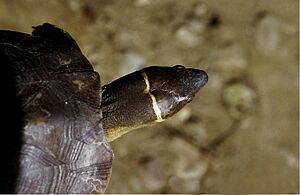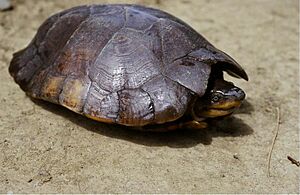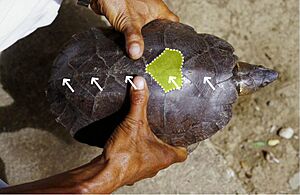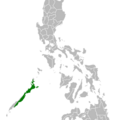Philippine forest turtle facts for kids
Quick facts for kids Philippine forest turtle |
|
|---|---|
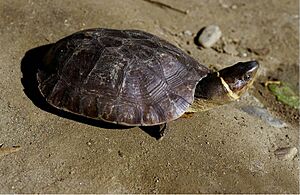 |
|
| Profile of Philippine forest turtle | |
| Conservation status | |
| Scientific classification | |
| Genus: |
Siebenrockiella
|
| Species: |
leytensis
|
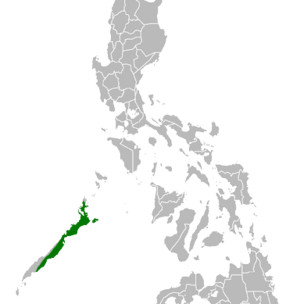 |
|
| Known areas of occurrence of Siebenrockiella leytensis. | |
| Synonyms | |
|
|
The Philippine forest turtle (scientific name: Siebenrockiella leytensis) is a special kind of freshwater turtle. It lives only in the Philippines and is sadly critically endangered. This means it is at high risk of disappearing forever.
People also call it the Philippine pond turtle, Palawan turtle, or Leyte pond turtle. Even though it's called the Leyte pond turtle, it actually doesn't live on the island of Leyte. Instead, it lives in the Palawan island group. In the Cuyonon language, locals call it bakoko.
You can easily spot Philippine forest turtles by their unique shell patterns. They have ginkgo-shaped scales on their back. They also have a light white or yellow line across their head, right behind their ears. This line makes them look like they're wearing a "bowtie," which is why some people call them the 'bowtie turtle'.
The Philippine forest turtle belongs to a group called Panyaenemys. It is one of two species in the Siebenrockiella family, the other being the smiling terrapin (Siebenrockiella crassicollis).
Contents
What Does It Look Like?
Philippine forest turtles have shells, called carapaces, that are brown, reddish-brown, or black. Their shells can grow up to 21 cm (8.3 in) long. Some rare, very large turtles can reach 30 cm (12 in). The front edge of their shell can be a bit jagged or very jagged. The scales on the middle of their back are wider than they are long.
The bottom part of their shell, called the plastron, is usually reddish-brown or black. Sometimes it has yellow spots. Young turtles have a completely yellow plastron. The part that connects the top and bottom shells (the bridge) is the same color as the plastron.
The skin on their legs, body, and neck feels rough. It has tiny bumps. Their head is brown, sometimes with light brown, orange, or red spots near their temples. A thin white or pale yellow line goes across their head, right behind their ears. This line might be broken in the middle for some turtles. This is why they are sometimes called the 'bowtie turtle'. This line is easier to see on younger turtles.
Their upper jaw is hooked, and the skin on the sides of their neck and chin is lighter. Sometimes, their lower jaw has two small yellow spots on the sides.
Their legs have large, uneven scales. The front of their legs is darker. All their feet are webbed and have big claws on every toe. Their tail is a uniform light brown color.
It's quite easy to tell Philippine forest turtles apart from other turtles. They have special ginkgo-leaf-shaped scales on their back. They also have that light line behind their head.
Only two other turtle species have ginkgo-shaped scales: the Malaysian giant turtle (Orlitia borneensis) and the smiling terrapin (Siebenrockiella crassicollis). However, these turtles do not have the white or pale yellow line on the back of their heads.
Scientific Name and History
The scientific name for the Philippine forest turtle is Siebenrockiella leytensis. It belongs to the Siebenrockiella family and a smaller group called Panyaenemys. It is part of the Geoemydidae family.
This turtle was once thought to be part of the Heosemys family. But in 2005, scientists found that it was more similar to the smiling terrapin. So, they moved it to the Siebenrockiella family.
The name Panyaenemys comes from the Pala'wan word panya-en. A local person in Palawan used this word to describe the turtles in 2003. It means 'enchanted'. People believed these turtles were favorite pets of the forest spirits. The -emys part comes from a Greek word meaning 'freshwater turtle'.
The name Siebenrockiella honors an Austrian zoologist named Friedrich Siebenrock. The specific name leytensis means 'from [the island of] Leyte'. This name is actually a mistake! The turtle is from the islands of Palawan, not Leyte.
Where Do They Live?
Philippine forest turtles are only found in northern Palawan and the islands around it. This includes Dumaran Island, where many of them still live in creeks. In other areas, like Taytay and San Vicente, their numbers are dropping quickly. The total area where they live is thought to be smaller than 100 square kilometers (about 38 square miles).
Life Cycle and Behavior
Not much is known about the life of the Philippine forest turtle because it is rare and was only recently "rediscovered." However, scientists have observed that these turtles seem to live a long time. They also have a good chance of surviving into adulthood. Like most turtles, they take a while to grow up and be able to have babies. But once they can, they can have babies many times throughout their lives.
Turtles that were rescued from illegal traders were kept in a large pool at Malabon Zoo in Manila. They were very shy and spent a lot of time hiding under rocks. It took them months to get used to being in captivity.
Observations show that these turtles eat both plants and animals (they are omnivores). They liked commercial turtle food and water plants. They were also seen hunting small fish and crabs. They were most active in the early morning and late evening, looking for food. They also moved around during the night. They didn't seem to enjoy basking in the sun much, but this might have been because they were in a zoo.
In the wild, Philippine forest turtles are known to eat figs.
Threats to Their Survival
The Philippine forest turtle is a fascinating freshwater turtle. Many turtle enthusiasts are very interested in it. Because it was so hard to find in the wild, and because its home is being lost, and because people try to collect them, this turtle is listed as critically endangered.
Philippine forest turtles do not do well when kept as pets. They get stressed easily, and male turtles can be very aggressive towards each other. Despite this, many of these turtles have been found for sale illegally. In 2009, over 171 turtles were seen for sale in Manila pet markets, especially in Chinese markets where they were cheaper. These animals are not sold openly, and some buyers are collectors from other countries. Most of the turtles for sale were young. Between 2009 and 2011, this turtle was the sixth most commonly seized animal in the Philippines. These turtles were taken from muddy areas in northern Palawan, where they are believed to hide during the day.
Some turtles sold from Palawan had small holes drilled in their shells. This shows that some had been kept as pets and tied up. Local people in Palawan sometimes keep these turtles in water troughs for their pigs. They believe it brings good luck to the household and the pigs.
There are also worries about illegal trade of Palawan turtles to places like Borneo and Malaysia.
Conservation Efforts
Some studies have started on the habitats of these turtles by academic groups in the Philippines. However, there isn't enough money for full studies. So, they are still considered endangered, especially from people collecting them. More research is needed.
It is against the law to trade these turtles internationally under the CITES convention. It is also illegal to trade them within the Philippines under the Philippines Wildlife Act.
About eighteen Philippine forest turtles have been given to the Malabon Zoo north of Manila.
New laws in the Philippines require pet owners and traders to register their animals with the government. They also have to pay for licenses to keep more "exotic" pets. It is hoped that this will help reduce the collection of endangered species, including the Philippine forest turtle. The entire Palawan group of islands is also a nationally protected area.
Images for kids



